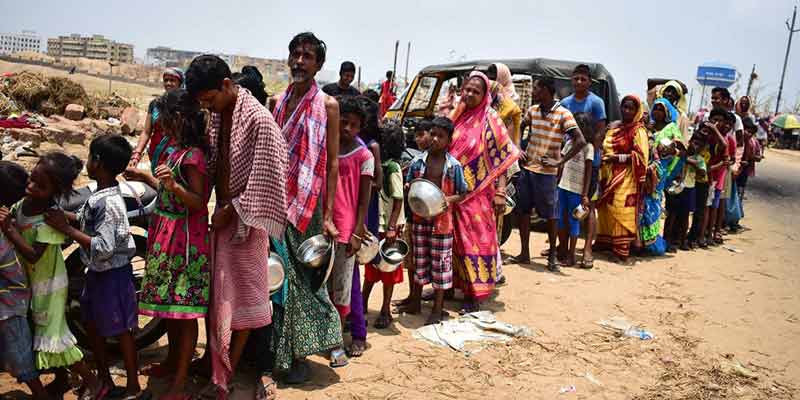- World
- May 02
5 mn people displaced in India in 2019
Nearly five million people were displaced in India in 2019, the highest in the world, due to disasters, including cyclones and monsoon floods, a new report by the Internal Displacement Monitoring Centre (IDMC) said.
The displacements were a result of a combination of increasing hazard intensity, high population exposure and high levels of social and economic vulnerability, the report said.
South Asia recorded 9.5 million new displacements associated with disasters in 2019, the highest figure since 2012 and the floods triggered by the monsoon in India and Bangladesh and cyclones Fani and Bulbul were among the events that forced most people to flee their homes both in the region and globally.
While India reported 50,37,000 displacements, Bangladesh recorded 40,86,520 in the year 2019. The other countries with new displacements are Afghanistan (5,78,000), Nepal (1,21,000) and Pakistan (1,16,000), according to the data provided in the report by the Geneva-based centre.
What is internal displacement?
Internal displacement takes place in a multitude of contexts. Main triggers of displacement include armed conflicts, situations of generalised violence, human rights violations, sudden onset disasters and slow onset disasters.
Development investments, such as large infrastructure or urban renewal projects, can also cause displacement and human rights violations at a large scale.
In addition to the triggers, there are a range of structural conditions and underlying drivers of displacement: poverty and inequality, fragile and weak governance, rapid urbanisation, climate change and environmental degradation are some of these.
51 million people internally displaced globally
The number of internally displaced people (IDP) around the world who have been forced from their homes by conflict and disaster has reached an all-time high – 50.8 million last year – according to the report by IDMC.
The Global Report on Internal Displacement (GRID), published annually by IDMC, which is part of the Norwegian Refugee Council, estimates that 45.7 million people are living in internal displacement as a result of conflict and violence in 61 countries. The majority of those people are in Syria, Colombia, the Democratic Republic of the Congo (DRC), Yemen and Afghanistan.
Another 5.1 million people in 96 countries are displaced because of disasters. This includes 1.2 million people displaced by years of drought and floods in Afghanistan, more than 500,000 by monsoon rains in India and 33,000 whose lives are still uprooted a decade after the 2010 earthquake in Haiti.
33.4 million new displacements
Conflict and disasters triggered 33.4 million new internal displacements across 145 countries and territories in 2019. Most of the disaster displacements were the result of tropical storms and monsoon rains in South Asia and East Asia and Pacific.
Disasters triggered nearly three-quarters of the new displacements recorded worldwide in 2019, accounting for 24.9 million. More than 95 per cent were the result of weather-related hazards such as storms and floods.
The overwhelming majority of conflict displacements were triggered by armed conflict, but communal violence accounted for a significant proportion of the global total of 8.5 million.
Many evacuees, however, had their displacement prolonged because their homes were damaged or destroyed.
5 million people displaced in India
There were five million new disaster displacements in India in 2019, the highest figure in the world and the result of a combination of increasing hazard intensity, high population exposure and high levels of social and economic vulnerability.
The year was also the seventh warmest since records began in 1901, and the monsoon was the wettest in 25 years. These conditions helped to fuel the destructive power of the eight tropical storms to hit the country during the year.
The most severe was cyclone Fani, which tracked across the states of Odisha, Andhra Pradesh and West Bengal in early May, before moving north to Bangladesh. As it approached the coast of Odisha, the government organised the evacuation of more than 1.8 million people.
Another 2,89,000 people were evacuated in Gujarat in June ahead of cyclone Vayu, which changed track and reduced in intensity before making landfall later than expected.
The southwest monsoon triggered more than 2.6 million displacements in the months that followed.
The northwest monsoon continued to trigger displacement in October and November, along with cyclone Maha, which hit Kerala and the Lakshadweep islands on October 31.
“Cyclone Bulbul struck Odisha and West Bengal ten days later, triggering 1,86,000 displacements,” it said.
The report said drought displacement was also recorded in the states of Andhra Pradesh and Maharashtra.
“Water shortages in Maharashtra between March and June forced about 50,000 farmers and their families to take refuge in cattle camps, displacement sites run by NGOs where livestock is also fed and watered,” the report said.
According to the report, “conflict and violence” triggered about 19,000 new displacements in the country last year.
“Political and electoral violence, primarily in Tripura and West Bengal in the first half of the year, accounted for more than 7,600. Lesser unrest and inter-communal violence continued to trigger displacement in the second half of the year,” the report said.
Finding solutions
There were visible efforts to prevent and respond to internal displacement in 2019, and promising developments in a number of countries highlighted the key ingredients for success.
New national initiatives showed greater levels of political commitment. Countries such as Niger and Somalia improved their policy frameworks on internal displacement.
Others, including Afghanistan, Iraq and the Philippines, incorporated displacement in their development plans, in their reporting on the Sustainable Development Goals, or when updating risk management strategies in line with the Sendai Framework for Disaster Risk Reduction.
Strengthened capacity across humanitarian and development sectors manifested in better coordination and increased investment. Improvements in the quantity and quality of data available also enabled better reporting and analysis, which in turn informs more effective responses and risk mitigation measures.
Manorama Yearbook app is now available on Google Play Store and iOS App Store

